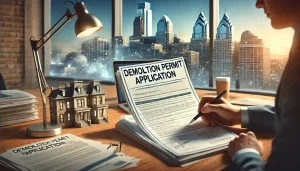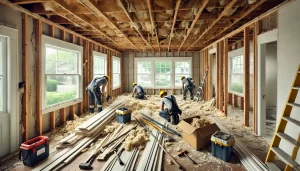Completing a building demolition successfully in Connecticut requires proper planning for site clean-up and restoration. Failure to follow Connecticut’s extensive environmental regulations during and after tear-down leads to steep fines or criminal charges. This guide examines key compliance responsibilities regarding waste handling, contamination controls, safety monitoring, and site rehabilitation as dictated by state mandates:
Hazardous Building Materials Require Special Handling
Before demolition crew equipment tears into structures slated for removal, state-licensed environmental inspectors test for and identify any dangerous substances requiring special disposal. Common hazardous demolition waste includes:
Asbestos – Asbestos fibers in older building insulation, floor tiles, siding, and roofing shingles prompt respiratory diseases like mesothelioma when particles become airborne. Asbestos abatement professionals fully remove sources as the first step before on-site demolition crew mobilization.
Lead Paint – Lead particle inhalation or ingestion prompts severe cognitive damage over time, especially in young children. Lead abatement contains risks of additional contamination during structural demolition, so licensed specialists handle careful remediation.
PCBs – Once extensively used as coolants and lubricants in building electrical equipment like fluorescent light ballasts and transformers, PCBs (polychlorinated biphenyls) rank among the most toxic substances requiring careful containment and disposal.
For public health, licensed environmental services contractors must remove and transport dangerous demolition waste correctly per Connecticut’s regulations before site tear-down proceeds.
Site Contamination Prevention & Inspections
Demolition activities inevitably release lead, asbestos, chemical or sedimentary dust, and debris into surrounding soil or water supplies without preventative actions. Sites also sometimes harbor lingering subsurface pollution from former commercial/industrial activities requiring remediation.
Connecticut holds demolition contractors fully responsible for containing on-site environmental hazards as well as checking for past land contamination issues before mobilizing. Negligence leads to stiff fines or lawsuits.
Submission of Asbestos Abatement Plans
The site owner or demolition contractor submits asbestos inspection reports and abatement plans detailing removal by licensed specialists to the Connecticut Department of Energy and Environmental Protection (DEEP) for review before issuing demolition approvals.
Phase I & II Environmental Site Assessments
Environmental consultants investigate the site’s past uses to determine if prior contamination exists from leaking oil tanks or hazardous commercial operations. Testing often includes soil, groundwater and/or soil gas evaluations. Sites containing or releasing pollutants require regulatory clean-ups beforehand.
Compliance With Demolition Materials Transport Laws
Hauling away and disposing of building construction and demolition debris (like wood, masonry, concrete, drywall, roofing, siding, etc.) also fall under strict Connecticut environmental regulations and oversight:
Waste Transporter Licenses
Trucks hauling demolition waste without proper licensing face penalties. Annual transporter permits require vehicle inspections, bonding, insurance, and compliance history reviews first.
Waste Categorizations & Facility Restrictions
Connecticut classifies demolition debris into Categories 1, 2, and 3, dictating approved receiving and processing facilities for disposal. Category 1 soils have the highest contamination levels—needing specialized landfills, while Category 2 materials work for standard construction and demolition outfits after testing.
Documentation Protocols
To comply, truck drivers must maintain waste shipment records like accurate category classifications and disposal destinations while transporting demolition debris. Paperwork audits occur sometimes.
Post-Tear-Down Best Practices
Conducting thorough site clean-ups and erosion controls following structure demolition help prevent environmental citations in Connecticut. Recommended guidelines include:
Removal Verifications
Eliminate all visible wood, bricks, concrete chunks, rebar, rubble, and traces of hazardous waste per Connecticut waste-clearing mandates. Check for hidden debris piles or fragments throughout the site.
Temporary Erosion Controls
Install sediment barriers like silt fencing around the site perimeter until vegetation or long-term drainage/erosion controls are established. This minimizes soil loss entering storm drains or water bodies during weather events.
Site Grading & Contours
Grade and contour demolished sites to appropriate elevations, facilitating future stormwater drainage and soil stability; this helps curb sediment runoff issues.
Environmental Monitoring
Conduct ongoing monthly site runoff and soil analysis to detect any emerging contaminant leaks needing mitigation under Connecticut environmental policies before infill construction.
Soil Amendments & Stabilization
Blend demolition residual soils with nutrients, compost, gravel, or geosynthetic grids to accelerate site vegetation growth for permanent erosion control and stability.
Surety Bonds
Some municipalities require demolition contractors to furnish surety bonds up to $10,000, guaranteeing sufficient site clean-up and restoration once structures are cleared. These are held until inspection approvals.
Proactive site clean-ups demonstrate strong regulatory compliance, environmental stewardship benefiting community health, and responsible business conduct—all positives for Connecticut.
For expert guidance on demolition permits plus environmental services meeting Connecticut demolition standards, consult Bella Contracting Services.





